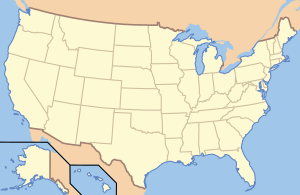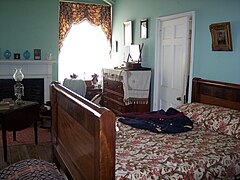Arlington House, The Robert E. Lee Memorial
|
Arlington House, The RE Lee Memorial
|
|
|
Photochrom postcard of the manor house, ca.1900 |
|
| location | Arlington , USA |
| surface | 112,900 m² |
| Geographical location | 38 ° 53 ' N , 77 ° 4' W |
| Setup date | March 4, 1925 |
| administration | National Park Service |
Arlington House , the (RE Lee Memorial), is a neo-Greek style mansion in Arlington County , USA and was once the home of Confederate General Robert E. Lee . It sits above the Potomac River , directly across from the National Mall in Washington, DC During the Civil War , the home's lot was chosen as the location for Arlington National Cemetery , in part to ensure Lee would never be able to return to his home.
Construction time and early history
The mansion was built on behalf of George Washington Parke Custis , a step-grandson of George Washington . He was the most famous resident of Alexandria County, which was then part of the District of Columbia . The home was built on 445 acres of land that Custis' father, John Parke Custis , purchased in 1778. Custis named the house Arlington, after the name of his family's estate on the east coast of Virginia. The house was designed by the English architect George Hadfield , who also worked on the United States Capitol . The north and south wings were completed between 1802 and 1804. The large central area and the portico with a length of 43 meters were completed 13 years later. The house has a summer and a winter kitchen. The most striking feature of the house are the eight massive pillars of the portico .
In his day, Custis was Alexandria County's most famous resident and he hosted many of the most famous men of the day, including Marie-Joseph Motier, Marquis de La Fayette , who visited in 1824. At Arlington, Custis experimented with new methods of animal husbandry and other areas of agriculture . The property also included Arlington Spring , a picnic area on the banks of the Potomac. He had initially built it for private purposes, but later made it accessible to the public in order to use it commercially.
His daughter, Mary Anna Randolph Custis, was his only child who reached adulthood. Young Robert E. Lee, whose mother was a cousin of Mrs. Custis, visited Arlington frequently. Two years after graduating from West Point on June 30, 1831, Lieutenant Lee married Mary Custis on Arlington. For 30 years, Arlington House was the home of the Lees. For a large part of their marriage they commuted between US Army locations and Arlington, where six of their seven children were born. They shared the house with Mary's parents.
When George Washington Parke Custis died in 1857, he bequeathed the Arlington Estate to his daughter and appointed his eldest grandson, George Washington Custis Lee, to be her heir. The property needed a lot of repairs and remodeling, so until 1860 Lee was exempt from the army to make the agricultural and financial improvements.
Civil War
After the outbreak of the Civil War in 1861, Virginia separated from the Northern States . Colonel Robert E. Lee, who at the time served 35 years in the US Army, was offered command of the Union Army . Lee felt that he could not expect the citizens of Virginia to do this. Instead of taking command, he decided to quit his job. He then reported for duty in Richmond , as commander of the Virginia Provisional Army. A short time later he went to the Confederate States Army and was promoted to general. Lee was concerned for the safety of his wife, who still lived in the mansion. He was able to convince her to leave the property, at least temporarily. She managed to keep some of the family's valuables safe.
Union units occupy Fort Sumter Lee's property a month after and use it as the headquarters of the belt of fortifications that covered Washington DC. A large part of the remaining family property was brought to the patent office for safekeeping . Some heirlooms, including Mount Vernon , had already been looted and scattered.
In 1864 the military cemeteries in Washington DC and Alexandria were overflowing with Union dead. The Quartermaster General Montgomery C. Meigs quickly dialed Arlington as a center for a new cemetery. Meigs, who was from Georgia , had served in the US Army under Lee and hated his former comrade who was now fighting the Northern States. He ordered that graves should be made right outside the front door of the house. This should prevent the Lees from ever returning. Meigs personally oversaw the funerals of 26 Northern soldiers in Ms. Lee's rose garden. Meig's son was killed in the war in October. He was also buried at Arlington.
Neither Robert E. Lee nor his wife set foot on their property again. Mary Custis Lee visited the site shortly before her death, however emotions became overwhelming and she was unable to enter.
post war period
In 1864 the government claimed that property taxes had not been paid and confiscated the property. Robert E. Lee and his wife have never taken legal action against it. In 1870, following the death of his father, George Washington Custis Lee , the eldest son of Robert E. Lee, filed a lawsuit in Alexandria court. The proceedings went to the Supreme Court , which only awarded Custis Lee compensation for the house and the 4 km² property. Lee had asked for $ 300,000 but got only $ 150,000, the supposed market value of the property.
In 1920 the Virginia General Assembly renamed Alexandria County to Arlington County . This was done to honor Robert E. Lee and to end the incipient confusion between Alexandria County and the city of Alexandria.
In 1925 the War Department began restoring the mansion and control was transferred to the National Park Service in 1933 . In 1955, Congress named the house a Memorial to Lee, and in 1966 it was listed on the National Register of Historic Places .
Today the house is administered as a memorial to Robert E. Lee by the National Park Service, while the area around the house known as Arlington National Cemetery is managed by the Department of the Army .
credentials
- The National Parks: Index 2001-2003 . Washington: US Department of the Interior .
Web links
- National Park Service: Arlington House, The Robert E. Lee Memorial (official site; English)
- National Park Service: Arlington House - Virtual Museum





